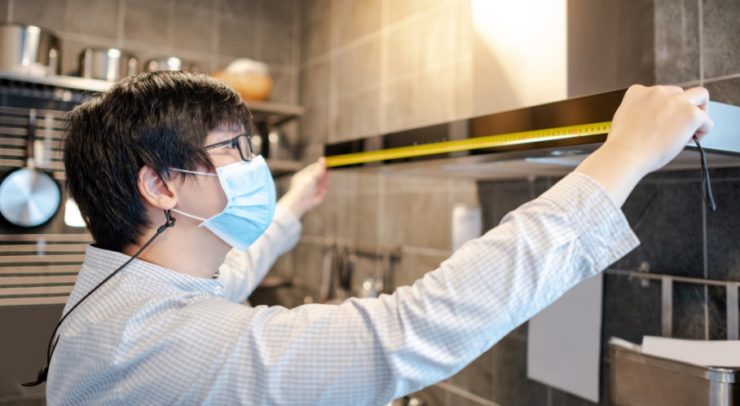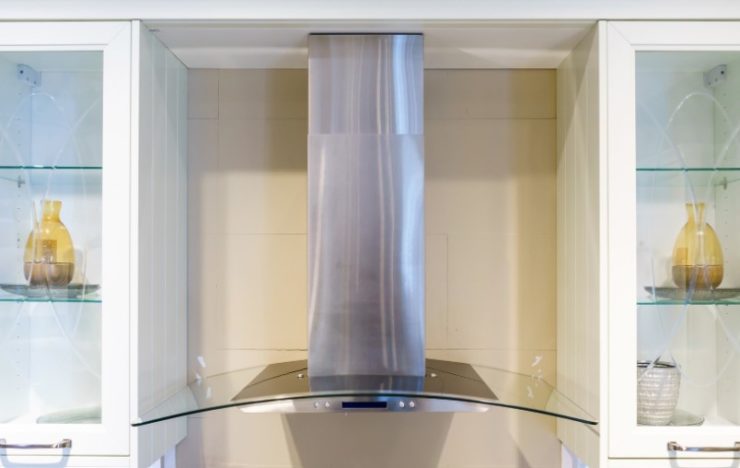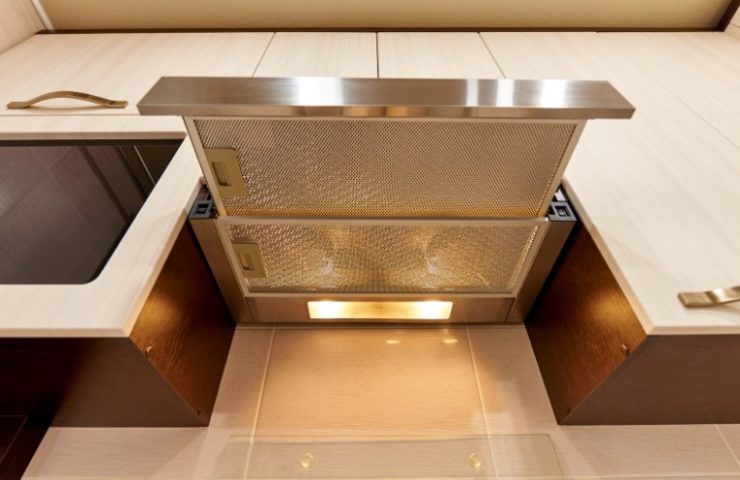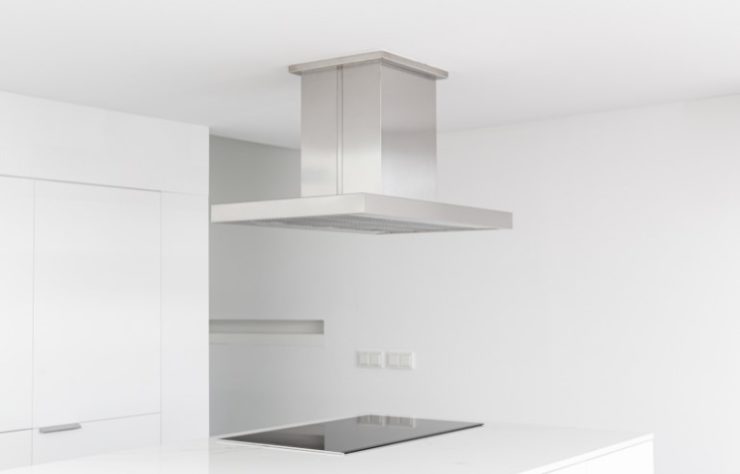If you’re in the market for a new range hood, choosing the right size is one of the first steps in the process. As a rule of thumb, you should get a range hood that is 6-inches wider than your cooktop.
The process is pretty straightforward, but getting the size right is only the tip of the iceberg.
Today, we’ll walk through choosing the right size range hood, plus I’ll share other important factors that will help you choose the best hood for your home.
In This Article
How To Choose The Right Size Range Hood

Picking the right size range hood will ensure that your ventilation system will effectively clear smoke and keep your kitchen air clean.
The “right” size hood will primarily be determined by the size of your cooktop. In most cases, you want your hood to be 6-inches wider than your cooktop. That gives you an extra 3-inches of overhang on each side.
Having a hood that is wider than your cooktop creates a larger capture area. That makes the hood much more effective at removing all or at least most of the fumes created while you cook.
If your hood is smaller than your cooktop, there will be a lot more smoke, steam, and other fumes that can escape and end up lingering in the air you breathe.
If you don’t have the space above your stove, you might be able to get by with a hood that is the same width as your range. But if that’s the case, you’ll want to go with a more powerful option with enough suction to clear the air before it escapes into the rest of your home.
Below, I’ve created a quick guide that will show you the best size range hood for the most common cooktop sizes. Simply measure the width of your cooktop and refer to the guide below to find the best size for you.
| Range Size | Recommended Hood Size | Minimum Hood Size |
|---|---|---|
| 24” | 30” | 24” |
| 30”* | 36” | 30” |
| 36” | 42” | 36” |
| 42” | 48” | 42” |
| 48” | 54” | 48” |
| 54” | 60” | 54” |
| 32” Grill** | 42” | 38” |
*30 inches is the most common range size in the US.
**Grills produce more heat and smoke, making the minimum and recommended hood sizes larger than standard cooktops.
How Powerful Should A Range Hood Be?
As you can see, choosing the best hood size is a pretty straightforward process. But deciding how powerful your hood should be can be a little more tricky. It depends partially on the size of your stove, but also, and maybe more importantly on your cooking style.
Range hood power is generally referred to in terms of CFM. That stands for Cubic Feet Per Minute, and it’s the amount of air the hood is capable of moving. Higher CFM means more airflow. More airflow means more smoke and fumes can be removed from above your range, faster.
The basic formula to find the minimum CFM for an electric or induction cooktop is simply the width of your stove multiplied by 10. So if you have a 30-inch electric cooktop, you would want a hood with at least 300 CFM (30×10=300).
Gas stoves have different venting requirements and so there’s a different formula if that’s what you’re working with. For gas, you’ll take the range’s total BTUs and divide that by 100. If your range puts out a total of 50,000 BTUs, you’ll want a hood with at least 500 CFM (50,000/100=500).
If you don’t cook very often, only cook with 1 or 2 burners at a time, or don’t do much high heat cooking, you can probably get away with the minimum CFM for your stove.
But, if your stove is often packed with pots and pans, you do any indoor grilling, or a lot of Asian cooking with a wok or high heat stir-fries, you’ll want to bump your CFM up a notch or three.
When in doubt, more CFM is almost always better. After all, you can always use a lower fan setting on a regular basis, but it’s nice to have a little extra when things start heating up in the kitchen.
Ducted vs. Ductless Range Hoods

Another decision you’ll be faced with once you’ve selected your hood size is if it will be ducted or ductless. So what’s the difference?
Ducted hoods are attached to ducts, or vents, that lead outside. So when they suck air up from above your stove, that “dirty” air is actually removed from your home and sent outside.
Ductless hoods, as you may have suspected, aren’t connected to ductwork. Since they don’t have anywhere to send smoke and other fumes, they rely on carbon filters to “clean” the air. Then, that air is recirculated back into your kitchen.
In general, ducted hoods are much more effective at removing contaminated air and keeping the air in your kitchen clean. They’re also much more efficient and can remove more smoke and fumes, faster than ductless models.
The only real downside to a ducted system is that it’s expensive to install if the ductwork isn’t already in place. And sometimes in condos and apartment buildings, it’s simply not an option. But if you already have ductwork in place, definitely take advantage and go with the ducted option.
A ductless hood can still offer solid ventilation and is always better than no hood at all. If you don’t cook very often, or have a small kitchen or small stove, a ductless hood is an easy and inexpensive solution.
Duct And Chimney Size
Ducts are what connect your hood to the outside. And the size of your ducts are tied directly to how powerful, or how many CFM, your hood has. Higher CFM hoods move more air so they need wider ducts to effectively do that.
Here is a chart so that you can see at a glance, what size duct is recommended based on your hood’s CFM.
| CFM | Duct Diameter Inches |
|---|---|
| 150-600 | 4-6 |
| 600-900 | 7-10 |
| 900-1200 | 8-12 |
| 1200+ | 10+ |
If your hood has a chimney like most wall-mount options do, you shouldn’t have anything to worry about so long as you have a ceiling that’s between 7-9 feet high.
Most hood chimneys are designed with telescoping sections so that they can be adjusted to fit most common ceiling heights. However, if you have very high ceilings and there is additional ductwork visible you may have to buy an additional chimney extension.
Chimney extensions are widely available from most hood manufacturers so you can get one that matches the rest of your hood perfectly.
Next Steps

Now that you’ve chosen the right size range hood and are armed with the knowledge to make a more informed decision, it’s time for the fun part. Actually looking at the hoods that match your kitchen and cooking style.
We’ve spent countless hours researching the best hoods for all types of kitchens and cooks. And below you’ll find some of our roundups of the best hoods by size, power, and noise level. Happy hood hunting!
Frequently Asked Questions
Can A Range Hood Be Too Powerful?
A range hood is too powerful if it removes air from a room faster than it can be replaced. This isn’t very common but can happen especially in very small kitchens. Leaving a window or door open to the outside is one way to avoid this problem.
Are Ductless Or Ducted Range Hoods Better?
Ducted range hoods are better and more efficient at removing contaminated air and keeping the air in your kitchen and home clean. Ductless hoods recirculate air back inside and are limited on how quickly and effectively they can keep air clean.
Is It Possible For A Range Hood To Be Too Big?
A range hood should be about 6-inches wider than your cooktop. Anything larger than that isn’t necessarily a bad thing but won’t provide much benefit.







